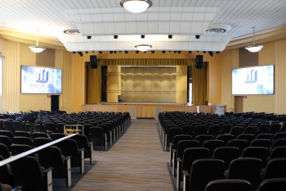- Phoenix College, the flagship institution of the Maricopa County Community College District, has recently adopted a video solution provided by NanoLumens. With the help of NanoLumens, Phoenix College has been integrating 21st century technology into a 20th century architectural masterpiece.
Phoenix College's Bulpitt Auditorium with new NanoLumens video screens
“In 1939 Phoenix College retained the architectural firm of Lescher and Mahoney with Public Works Administration funds to design the first six buildings for the new campus,” explained Mike Poplin, Director of Technology Support and Media Services, Information Technology Department. “The Arts and Science buildings; gymnasium; combination library, Bulpitt Auditorium and administration building; cafeteria; and a central heating plant formed the core of the college for many years.”
The Bulpitt Auditorium serves as the centerpiece for Phoenix College and hosts many important college, district and community events, explained Dr. Mark Koan, CIO and Dean of Information Technology. “As we considered the range of diverse events hosted in this venue, as well as the college’s commitment to innovation, we focused our design goals on enhancing the auditorium’s historic appeal with state-of-the-art lighting, audio, and video technology. When we found the video solution from NanoLumens, we knew we had to find a way to work it into the budget. We couldn’t be more pleased with the results.”
According to Doug McCarthy, Director, Phoenix College Facilities Planning & Development, great care was exercised in the planning and execution of the auditorium’s renovation to preserve the integrity of the Art-Deco/Early Mid-Century design while bringing it up to current code compliance and functionality. “Chip Shay of SPS+ Architects was retained to design the project. Chip is a certified acoustician who also has a great deal of experience in theater renovation. The success of this project was a result of a strong collaboration with the college’s Facilities Planning, Administration, Music, and IT departments.”
The renovation involved the installation of new electric rigging and drapes, LED lighting, mechanical systems, structural enhancements and cosmetic renovations. Great care was taken in the selection of the finishes, windows, lighting devices and colors to enhance and capitalize on the original design of the building. Even the original outside lighting fixtures were refurbished and reused. These fixtures are now re-installed with LED lamps. Each need examined in the planning and completion of this project was reviewed for relevance from a functional and historic standpoint.










